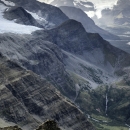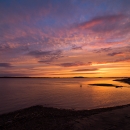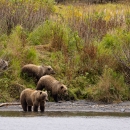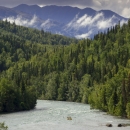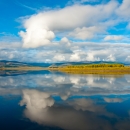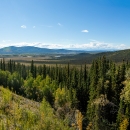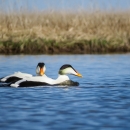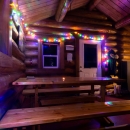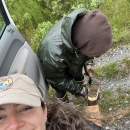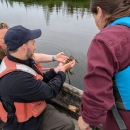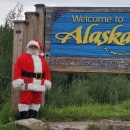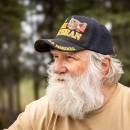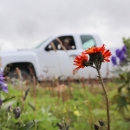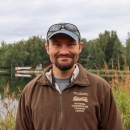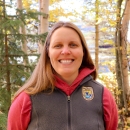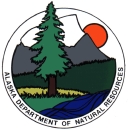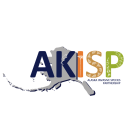Invasive Species Program staff collaborate with Alaska's National Wildlife Refuge, the State of Alaska and other partners to protect Alaska's lands and waters by working to detect invasive species invasive species
An invasive species is any plant or animal that has spread or been introduced into a new area where they are, or could, cause harm to the environment, economy, or human, animal, or plant health. Their unwelcome presence can destroy ecosystems and cost millions of dollars.
Learn more about invasive species infestations while they’re still relatively small and have the highest chance of being successfully eradicated. We survey terrestrial, freshwater, and marine environments for invasive plants and animals. Survey methods include activities such as raking lakes for the submerged aquatic plant Elodea, surveying roads for invasive plants like white sweetclover or orange hawkweed, and setting traps for invasive green crabs.
The Conservation Genetics Labin Anchorage is refining existing genetic analyses by developing or verifying genetic markers for invasive species not yet present in Alaska to detect invasive species environmental DNA (eDNA) from water samples.
Data from early detection surveys are entered into databases such as the Alaska Exotic Plants Information Clearinghouse. Anybody can help with early detection efforts by reporting plants or animals that you may be unfamiliar with to 1-877-INVASIV, ADF&G Online Reporter, or via the Alaska Invasives ID app.
Early Detection Projects Across the National Wildlife Refuges:
Arctic: We surveyed roadsides for white sweetclover and other invasive plants along the Dalton Highway and other avenues leading into the Refuge. We also surveyed high-risk lakes for invasive aquatic plants like Elodea. Local contact: Heather Bartlett
- Alaska Maritime: We visited several islands in 2021 to look for signs of a rat infestation such as tracks and scat. Some of the islands visited were known to have rats prior. Several islands were unknown to have rat infestations but were within swimming distance from the infested island. For islands known to have rats, we set trap lines to collect samples. For islands with an unknown status, no rat sign was detected. Local contact: Lauren Flynn.
- Alaska Peninsula and Becharof: During summer of 2021, we conducted terrestrial invasive plant surveys at critical access points, roadways, and areas with high human disturbance around King Salmon and Naknek. We also surveyed for Elodea and other invasive aquatic plants in lakes and streams with a high concentration of floatplane traffic and water-based recreation on the Refuge. Local contact: Danny Moss.
- Innoko: Survey efforts were not completed in 2021. Local contact: Karin Bodony.
- Izembek: During summer of 2021, we conducted terrestrial invasive plant surveys at critical access points, roadways, and areas with high human disturbance around the Refuge and Cold Bay. We also surveyed for Elodea and other aquatic plants in lakes and streams on the Refuge with a high concentration of floatplane traffic and water-based recreation. We looked for marine invertebrates, especially invasive crabs, by setting traps around the Cold Bay pier. Local contact: Alison Williams.
- Kanuti: Terrestrial plant surveys were done along the Dalton Highway and at potential points of introduction into the Refuge during summer of 2021. We paid special attention to looking at whether white sweetclover had colonized gravel beds downstream of the Refuge. We also surveyed for Elodea and other invasive aquatic plants in lakes and streams with a high concentration of floatplane traffic on the Refuge. To date, no Elodea has been found in sampled lakes. Local contact: Chris Harwood.
- Kenai: Efforts continue to monitor for invasive Northern pike in the Miller Creek Watershed post-treatment. Survey efforts have not yet been done. Local contact: Matt Bowser.
- Kodiak: In 2021, coastal surveys for terrestrial plants were completed across 12 different locations on and off Refuge lands. Survey locations were based on critical control points such as at the Visitor Center and the Buskin River watershed. Local contact: Bill Pyle.
- Koyukuk and Nowitna: Survey efforts were not completed in 2021. Local contact: Karin Bodony.
- Selawik: Survey efforts were not completed in 2021. Local contact: Bill Carter.
- Tetlin: In the summer of 2021, we conducted invasive species survey along the Alaska Highway and Tetlin Refuge border to evaluate the spread of invasive species, in particular looking for white sweetclover and bird vetch. We also surveyed waysides, trails, Refuge bunkhouses, and campgrounds. Several lakes were surveyed for Elodea and other aquatic vegetation. Surveys are planned for summer of 2022 to look for Elodea in other remote lakes as well as for terrestrial plants in the fiber line right of way. Local contact: Ross Flagen.
- Togiak: Between July - October of 2021, we surveyed for Elodea and other invasive aquatic plants in lakes and streams using aerial surveys, water surface surveys, and fragment searches. We also utilized a lake rake to collect aquatic plants for identification. Surveying and identification efforts for aquatic invasive plants have been conducted on the Refuge annually since 2018. Local contact: Kara Hilwig.
- Yukon Delta: Survey efforts were not completed in 2021. Efforts planned for 2022 to do terrestrial plant surveys on Nunavak. Local contact: Kyra Neal.
- Yukon Flats: In 2021, we traveled downstream by boat from Fort Yukon to Circle in order to survey gravel bars for invasive plants. In particular, we looked for white sweetclover to better understand the reach of its spread. Invasive plants were not found, but challenging water conditions made accessing several of the planned sites difficult. Local contact: Delia Vargas Krestinger.





